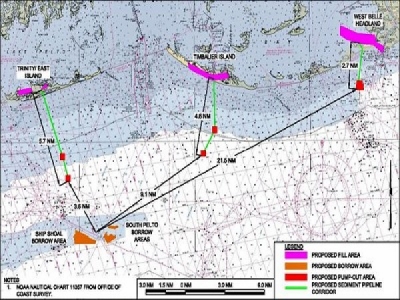
Posted on November 27, 2018
Louisiana will receive $161.4 million from the National Fish and Wildlife Foundation to continue its reconstruction of barrier islands and shorelines in the Terrebonne Basin, with the money coming from settlements of criminal charges with BP and Transocean for their roles in the 2010 Deepwater Horizon disaster and oil spill.
Louisiana’s money was part of $280 million in awards by the foundation on Monday (Nov. 19) for new projects, including 20 in Alabama, Florida and Texas.
The money will be used to rebuild the shorelines of the Belle Pass Headland, a peninsula of land in Lafourche Parish that stretches west from Port Fourchon, and Timbalier and Trinity islands in Terrebonne Parish, all of which have been subject to rapid erosion by hurricanes and winter storms, and are facing threats from sea level rise.
Sand for the restoration will come from the Ship Shoal and South Pelto underwater sand deposits, about 8 miles to 24 miles away from the beaches in the Gulf of Mexico. The two shoals are controlled by the federal Bureau of Ocean Energy Management.
“This is another significant project to help restore damages incurred by the BP oil spill,” said Gov. John Bel Edwards in a news release. “Investing in Louisiana’s critical barrier island chain will also help protect citizens living in the vicinity of Terrebonne and Timbalier Bays.”
The state’s coastal master plan focuses on rebuilding the islands and adjacent headlands to both act as speed bumps for hurricane storm surges, and to cut off the flow of tidal water within bays that also help cause erosion of interior wetlands.
“One of the primary goals of the Gulf Environmental Benefit Fund is to provide lasting and future benefits to types of natural resources impacted by the Deepwater Horizon oil spill,” said Jeff Trandahl, executive director and CEO of NFWF in a statement.
The Trinity project involves restoring a 1,000-foot-wide beach on the west end of Trinity’s East Island, which is fronted by existing dune habitat. Breach-prone areas in the center of the island — where historic canals were located — will be filled in. The project will add material to increase the height of some areas to between 2 and 5 feet above sea level. Intertidal marsh habitat on the island will be elevated to between zero and 2 feet.
The project will require the use of about 2 million cubic yards of sand , with ranging from 1,000 feet along the western component and between 55 feet and 995 feet on the eastern component.
The Timbalier Island project will focus on the eastern part of the island, including construction of beach, dune and marsh components, with the dunes being elevated to 5 feet, the supratidal or “splash” zone — the area right along the front of the beach — will be elevated to 2 to 5 feet. The marsh will be raised to between zero and 2 feet.
The Timbalier project is about 9,000 feet long and will require about 4.2 million cubic yards of sand.
The West Belle Pass project will use the existing sand spit of an earlier beach renourishment project as a platform to restore about 10,500 feet of sand beach, dune and marsh. The project is expected to need about 800,000 cubic yards of sand for beach and dunes, which will be built to an initial elevation of about 7 1/2 feet.
The new projects were selected after NFWF officials consulted with CPRA, the U.S. Fish & Wildlife Service and the National Oceanic and Atmospheric Administration. More information on the projects are available on the NFWF web site.
Monday’s announced projects were included in the sixth round of awards from the benefit fund. The fund has so far awarded $1.3 billion, or more than half, of the money provided it as part of a settlement of federal criminal charges against BP and Transocean in 2013. Louisiana has so far received $625 million for 13 projects.
Under the terms of the settlement, $1.272 billion of $2.544 billion in penalty money was reserved for barrier island and sediment diversion projects in Louisiana. Other Gulf Coast states impacted by the spill split the remaining money.
Source: nola





